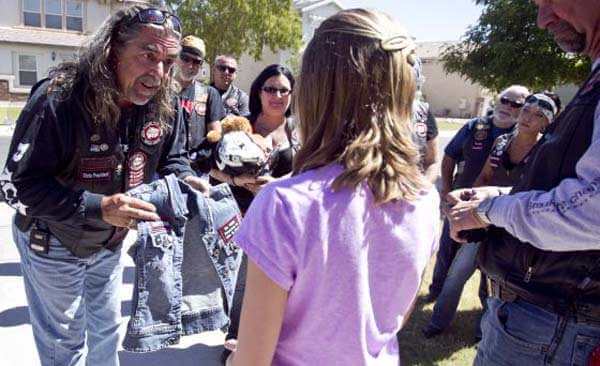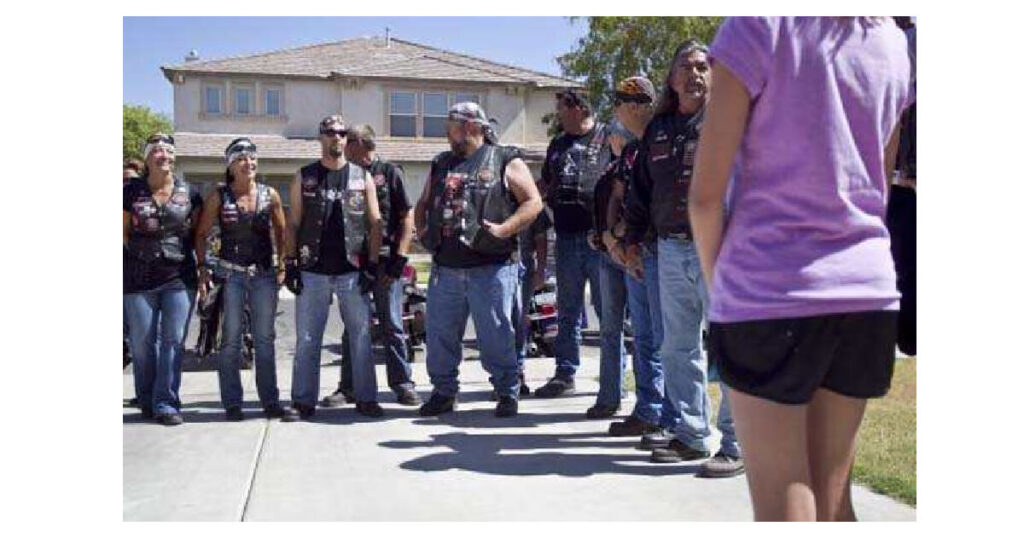Here is the Perfect example why you should never judge a book by it’s cover.
Bikers strike fear into the hearts of many. They’re seen as rough thugs… but there is more to a biker than you think. This gang, for instance, is happy to intimidate people. However, they only intimidate people who dare hurt children. They are the Bikers Against Child Abuse International.
And they mean business!
These tough bikers have a soft spot: aiding child-abuse victims. Anytime, anywhere, for as long as it takes the child to feel safe, these leather-clad guardians will stand tall and strong against the dark, and the fear, and those who seek to harm.
The girl chewing on her lip was abused by a relative, according to police reports – someone she should have been able to trust. He’s not in the state any longer, but the criminal case is progressing slowly, so he’s not in jail, either. He still terrorizes her at night, even though he’s nowhere near. She wakes, heart pounding. The nightmare feels real again. She never feels safe, even with her parents just downstairs. The unruly-looking mob in her driveway is there to help her feel safe again. They are members of the Arizona chapter of Bikers Against Child Abuse International, and they wear their motto on their black leather vests and T-shirts:
“No child deserves to live in fear.”
A biker’s power and intimidating image can even the playing field for a little kid who has been hurt. If the man who hurt this little girl calls or drives by, or even if she is just scared, another nightmare, the bikers will ride over and stand guard all night. If she is afraid to go to school, they will take her and watch until she’s safely inside. And if she has to testify against her abuser in court, they will go, too. Walking with her to the witness stand and taking over the first row of seats. Pipes will tell her, “Look at us, not him”. And when she’s done, they will circle her again and walk her out.
After all the bikers introduce themselves, Pipes holds up a small vest covered in patches. Just like the bikers’ but made of denim instead of leather.
On one patch is the girl’s new road name: Rhythm, for a girl who dances and plays music.

The bikers are all volunteers, giving five, 10, 20 or more hours a week. There’s no reimbursement for gas or the time they take off work. The bikers must be tough, not only to protect the kids but to be able to stomach knowing what their young charges may have been through. An 8-year-old beaten by Mom; a 6-year-old molested by his mother’s boyfriend. A girl, 10, raped. They are trained by a licensed mental-health professional affiliated with the chapter. Each biker must be fingerprinted and undergo a thorough criminal-background check, the same one required for state child-welfare workers and law-enforcement officers, before they can join the group.
They are bikers, not Boy Scouts, so if the background check turns up an arrest or a stint behind bars, they can still be in the group. The crime just can’t involve children, domestic violence or something comparable. They visit children only with permission and only in pairs, so no one is ever alone with a child.
The bikers aren’t looking for trouble. They are there so the kids don’t feel so alone, or so powerless. Pipes recalls going to court with an 8-year-old boy, and how tiny he looked on the witness stand, his feet dangling a foot off the floor. “It’s scary enough for an adult to go to court,” he says. “We’re not going to let one of our little wounded kids go alone.” In court that day, the judge asked the boy, “Are you afraid?” No, the boy said. Pipes says the judge seemed surprised, and asked, “Why not?” The boy glanced at Pipes and the other bikers sitting in the front row, two more standing on each side of the courtroom door, and told the judge, “Because my friends are scarier than he is.” Perfect example why you should never judge a book by it’s cover

